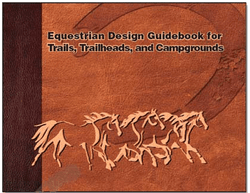Equestrian Design Guidebook for Trails, Trailheads, and Campgrounds
This guidebook provides practical guidelines for developing recreation environments that are sensitive to the needs of riders and their stock.
by
Jan Hancock, Principal, Hancock Resources LLC,
Federal Highway Administration,
USDA Forest Service

To keep the size and scope of this guidebook manageable, the focus is limited to equestrian elements--such as corrals, tread width, horse-friendly surfaces, and so forth--and a few closely related subjects. The information presented can be adapted to a variety of settings and levels of development, as well as to different jurisdictions. In many cases, the expertise of specialists--for example, engineers, landscape architects, and scientists--is required. Planners and designers should consult other sources for basic planning and design criteria, including agency-specific guidelines, legal requirements, engineering and architectural standards, scientific expertise, and so forth. Consulting with area riders is an essential part of the planning process. Sound planning and design judgment are the keys to choosing the most appropriate elements, given local conditions. This guidebook is intended as a practical guide for trail work, not a policy manual--however, the authors believe the information is consistent with current U.S. Department of Agriculture (USDA) Forest Service policies and direction.
View the guide

About the Authors
Jan is the author of two books, the “Equestrian Design Guidebook for Trails, Trailheads, and Campgrounds” published by the U.S. Department of Transportation Federal Highway Administration, in partnership with the USDA Forest Service, Missoula Technology and Development Center, and the guidebook titled “Horse Trails in Arizona.” She is an equestrian recreational facilities design consultant with her company, Hancock Resources LLC, and is a national speaker at trails and equestrian conferences and webinars. Jan has lived in Phoenix, Arizona over the past 40 years.
Jan has a Bachelor of Science degree from Northern Arizona University in Flagstaff, AZ, and a Master of Arts degree from Arizona State University in Tempe, AZ.
Jan served on the Arizona Governor’s Growing Smarter Oversight Council and is the equestrian representative on the American Trails Board of Directors. She served a 9-year term on the City of Phoenix Parks and Recreation Board and the Design Review Standards Committee. She was the past president of the Arizona Trail Association, the nonprofit support organization for the 800-mile Arizona National Scenic Trail, a border-to-border route that travels through lands managed by Federal, State, County, and Municipal agencies. Jan is a founder and the executive director of the Maricopa Trail + Park Foundation supporting the 315-mile Maricopa Trail, a loop spur trail system in the nation’s second-largest counties in the nation. Jaa is also a founding member of the Sun Corridor Trail Alliance, supporting the planning and construction of a 1,500-mile urban-centric trail system from Douglas, Arizona to Las Vegas, Nevada.
As an equestrian facilities and trails consultant, Jan has completed numerous master planning and trail system projects for cities and land management agencies across the United States. She is currently working on equestrian-use trails and trailhead planning for the City of Milton, GA, the City of Big Bear Lake and Big Bear Valley, CA, the Five Winds Ranch in Yucaipa, CA, and the Lake Arrowhead Trail System Master Plan in CA.
The daughter of a veterinarian, Jan has been horseback riding since she was three years old and has been horseback trail riding most of her life. She credits the remarkable saddle horses she has owned over her lifetime with the inspiration and passion for her career as an author and designer of equestrian-use outdoor recreational trails and related facilities.
Contact: [email protected]
The Federal Highway Administration (FHWA), part of the US Department of Transportation, provides expertise, resources, and information to improve the nation's highway system and its intermodal connections. The Federal-Aid Highway Program provides financial assistance to the States to construct and improve the National Highway System, other roads, bridges, and trails.
Visit Federal Highway Administration
To sustain the health, diversity, and productivity of the Nation’s forests and grasslands to meet the needs of present and future generations.
Visit USDA Forest Service
More articles by these authors
More articles in this category
Continental Divide National Scenic Trail Trailhead Design Guidelines
posted Nov 19, 2018
This document provides guidelines to help managers make decisions in a sustainable manner for major trailheads all along the CDNST. Overall principles given here relate to all trailhead sites. However, they also include more detailed guidelines specific to the highly varied settings along the Continental Divide.
Turning Homes into Trailheads
posted Feb 19, 2018
Join this session to learn how to build a public/private trail network that turns homes into trailheads.
5,313 views • posted 01/24/2018





